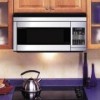Sharp R1870 R-1870 , R- 1871 , R-1872 , R-1874 Installation Instructions - Page 2
Electrical Grounding Instructions, Hood Exhaust Duct, Tools Recommended For Installation - sharpe
 |
View all Sharp R1870 manuals
Add to My Manuals
Save this manual to your list of manuals |
Page 2 highlights
3 ELECTRICAL GROUNDING INSTRUCTIONS This appliance must be grounded. This oven is equipped with a cord having a grounding wire with a grounding plug. It must be plugged into a wall receptacle that is properly installed and grounded in accordance with the National Electrical Code and local codes and ordinances. In the event of an electrical short circuit, grounding reduces risk of electric shock by providing an escape wire for the electric current. WARNING - Improper use of the grounding plug can result in a risk of electric shock. The oven is equipped with a 3-prong grounding plug. DO NOT UNDER ANY CIRCUMSTANCES CUT OR REMOVE THE GROUNDING PIN FROM THE PLUG. The Power Supply Cord and plug must be connected to a separate 120 Volt AC, 60 Hz, 15 Amp, or more branch circuit, single grounded receptacle. The receptacle should be located inside the cabinet directly above the Microwave Oven/Hood mounting location. Ground Receptacle NOTE: 1. If you have any questions about the grounding or electrical instructions, consult a qualified electrician or serviceperson. Opening for Power Cord 2. Neither Sharp nor the dealer can accept any liability for damage to the oven or personal injury resulting from failure to observe the correct electrical connection procedures. Figure 3 4 HOOD EXHAUST DUCT When the hood is vented to the outside, a hood exhaust duct is required. All ductwork must be metal; absolutely do not use plastic duct. Check that all connections are made securely. Please read the following carefully: Exhaust connection: The hood exhaust has been designed to connect to a standard 31/4" x 10" rectangular duct. If round duct is required, a rectangular-to-round adapter must be used. Rear exhaust: If a rear or horizontal exhaust is to be used, care should be taken to align the exhaust with the space between the studs, or wall should be prepared at the time it is constructed by leaving enough space between wall studs to accommodate exhaust. Maximum duct length: For satisfactory air movement, the total duct length of 31/4" X 10" rectangular or 6" diameter round duct should not exceed 140 feet. Elbows, adapters, wall, roof caps, etc. present additional resistance to air flow and are equivalent to a section of straight duct which is longer than their actual physical size. When calculating the total length, add the equivalent lengths of all transitions and adapters plus the length of all straight duct sections. Figure 4 shows the approximate feet of equivalent length of some typical ductwork parts. Use the values in parentheses for calculating air flow resistance equivalent, which should total less than 140 feet. Figure 4 5 TOOLS RECOMMENDED FOR INSTALLATION • Phillips Screwdriver • Electric Drill • Scissors • Pencil • Tape • 11/2" Wood Bit or Metal Hole Cutter (if metal cabinet is used) • 1/2", 5/8" and 3/32" Drill Bits • Saw to cut exhaust opening (if needed) • Measure • Protective Drop Cloth for product and range-you may also use carton for protection 2











